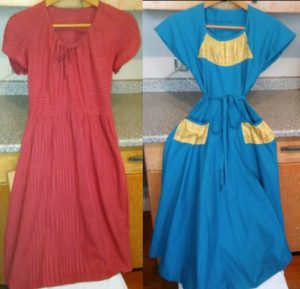At some point in the middle of writing my novel Marion Hatley, whose central character is a seamstress, I decided to make a few dresses for myself.
I thought this might bring me a little closer to Marion, although, unlike her, I wasn’t about to make anything of my own design; I just don’t have the skills or the eye for that. In the end, my most creative act in the whole process was choosing the patterns and fabrics.
Still, I hoped that the simple act of constructing a few things from start to finish, piece by piece and seam by seam, might give me more of a handle on Marion’s life—and, if I was lucky, turn up something unexpected.

In fact, the sewing turned out to be almost pure escapism. After long days of working on the novel or on freelance projects, my brain was tired, and during my evening hours with needle and thread, I fell into a kind of zoned-out rhythm, enjoying the steady, stitch-by-stitch sense of accomplishment and relieved that it made few mental demands. I thought little about Marion or her struggles, or about much else of substance. (I should say that I sewed all the dresses by hand, because I didn’t want to be rushed along by a sewing machine, or distracted by its noise.)
Eventually, the something unexpected did come along, though not while I was sewing. It came from writing about sewing, as in this part of Marion Hatley, when Marion remembers her late mother, Vera, also an expert seamstress:
Marion … pushed open the door to their sewing room and found Vera standing in her bathrobe, flushed and disheveled, over the pieces of a dissembled garment: a competitor’s corset. … Vera, as she had done countless times before, was studying a garment to understand it―in this case to discover how such innocent parts formed such a dastardly whole, and to see what might be done to improve the lot of the corset-wearing woman. …
That evening, Marion assisted Vera in one attempt—there were to be several more—to create an improved corset, one fitted to Vera. But at some point in the small hours, after several back-and-forths between the work table and sewing machine, Vera collapsed into the easy chair in the corner of the room. …
Now … Marion looked over those old scraps from the sewing room, and studied the model they’d toiled over that evening, a model that Vera had subtracted from and added to a few more times before death brought her efforts to an end. Although it was surely a disappointment to Vera, the work-in-progress captured her spirit more than anything else could have. It was a deep desire and struggle preserved, and Marion was so thankful to be able to hold it, to examine all the stitches and seams—ripped out, reconfigured, or preserved—a failed result but nonetheless beautiful, in Marion’s eyes, and still faintly scented with Vera’s sweat and Shalimar.
By immersing myself in scenes like the previous one, I realized how much the process of sewing, as I portrayed it in the novel, echoed my process of writing. In both enterprises, some struggle and failure are inevitable, and for me at least, they’re necessary for creating anything worth the effort.
Also, in my writing, as in sewing, there’s sometimes no other choice than to go back to square one and puzzle out what to do differently. Here’s a brief look at just such a point in Marion’s life:
Whenever Marion failed at attempts at something new or interesting—like sewing a yellow muslin collar on a red silk dress—Vera’s responses went like this:
“Why don’t you try something else.”
“Such as?”
“Look at the collar fabric.”
“What’s wrong with it?”
“Take another look, Marion. Look for yourself, and think.”
I’ve had to fail (a lot) at writing to make any progress with it, and I know that more failure lies ahead. But I keep going, mainly for the charge I get from those times when things just seem to flow, and I end up writing something that seems to have a life of its own, apart from mine—a life that feels real and true.
Here’s one such time for Marion, a night she spends sketching possible dress designs:
Working ahead Marion had that feeling of being on to something—a jazzed type of drive typical of sleepless, working nights of her youth, a drive that rarely produced anything that held up under the sober scrutiny of morning. Rarely, but there were occasional successes.
As long as I, too, have moments like these, I’ll keep writing.

Fun. Interesting. Amazing that you tolerated all hand sewing in your endeavor to understand Marion and her creative process and genius. I like your conclusion, “as long as I have moments like these, I’ll keep writing.” Good! I’ll keep reading!
Thanks for those kind words, Cynthia. I’m so grateful for the kindness and support that you and Patty have shown me these many years.